Ford Mustang V6 and Mustang GT 1994-2004: Fuse Box Diagram
A fuse box diagram offers a handy way to quickly and effectively identify the fuses that control your Ford Mustang.
This article applies to the Ford Mustang V6 and Mustang GT (1994-2004).
If a fuse blows in your 1994-2004 Ford Mustang, it's important to replace it immediately. You won't need to head down to a neighborhood Ford dealer for the repair. As long as you have a replacement fuse on hand, you can pop the hood of your car and install the small part right then and there. The job only takes a few minutes, and aside from a fuse puller, which is located in your fuse box, you won't need any special tools. However, you will need the fuse box diagram for your Ford Mustang to make sure you locate and replace the correct fuse. Use this article as a reference; you can also refer to your owner's manual for the diagram.
1994-1995 Ford Mustang Fuse Box Diagram
This 1994-1995 fuse box diagram is divided into three major sections: Fuse position, "amps" (or amperage) and circuits protected. The fuse position identifies the exact location of a fuse within the fuse box. The amperage identifies the strength of the fuse in question (e.g., 20 AMP vs. 30 AMP). The "circuits protected" section spells out in simple language which areas of your car the fuse protects.

1994-1995 Ford Mustang Fuse Box Diagram (Under Hood)
In addition to identifying amperage, fuse type, and circuits protected, this fuse box diagram also offers the color code used to identify high current fuses, as well as a diagram of where each fuse is located.

2000 Ford Mustang
The following fuse box diagrams are for the 2000 Ford Mustang GT and offer a detailed description of each fuse, including its location, amperage and circuits protected. The diagram uses letters (A-L) to identify specific components. For example, "A" corresponds to the fans and "L" corresponds to the power windows. Fuse "A" has an amperage rating of 30. Fuse "L" has an amperage rating of 40.



Common Questions
What is the proper way to remove a blown fuse?
Use a fuse puller to grab the fuse by the top, and then remove it from your fuse box. A pair of tweezers will also suffice. However, do not touch the fuse with your hands, as you could transfer oils to the fuse (which might not be blown) as well as the fuse box.
How much does a replacement fuse cost?
You can purchase a replacement fuse for as little as one dollar (and in many cases, for much less than that, particularly when purchasing replacement fuses in bulk). Fuses can be purchased through an online retailer or through your local auto parts store.
How important is amperage?
It's important to check the amperage before installing a replacement fuse. If you use the wrong fuse, a short could occur. Save costs by installing the correct fuse the first time.
Common Issues
Blown Fuses
Even if a fuse appears normal (e.g., no signs of black discoloration inside), it can still be blown. Check the fuse by holding it up to the light. If the center strip is broken, you will need to replace the fuse.
System Failure
If you experience multiple blown fuses, you could be dealing with a larger problem. For instance, one or more of your major systems could be overloaded, causing it to short circuit. In a worse case scenario, one of your car's major systems could be failing and in need of professional repair. Before installing a replacement fuse, check the size and rating.

Related Discussion and Site
- 1995 Ford Mustang Fuse Diagram - Mustangforums.com
- 2000 Ford Mustang Fuse Diagram - Miracerros.com






